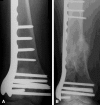2010 mid-America Orthopaedic Association Physician in Training Award: healing complications are common after locked plating for distal femur fractures
- PMID: 21424831
- PMCID: PMC3094618
- DOI: 10.1007/s11999-011-1870-6
2010 mid-America Orthopaedic Association Physician in Training Award: healing complications are common after locked plating for distal femur fractures
Abstract
Background: Several mechanical studies suggest locking plate constructs may inhibit callus necessary for healing of distal femur fractures. However, the rate of nonunion and factors associated with nonunion are not well established.
Questions/purposes: We (1) determined the healing rate of distal femur fractures treated with locking plates, (2) assessed the effect of patient injury and treatment variables on fracture healing, and (3) compared callus formation in fractures that healed with those that did not heal.
Patients and methods: We retrospectively reviewed 82 patients treated with 86 distal femur fractures using lateral locking plates. We reviewed all charts and radiographs to determine patient and treatment variables and then determined the effects of these variables on healing. We quantitatively measured callus at 6, 12, and 24 weeks. The minimum time for telephone interviews and SF-36v2(TM) scores was 1 year (mean, 4.2 years; range, 1-7.2 years).
Results: Fourteen fractures (20%) failed to unite. Demographics and comorbidities were similar in patients who achieved healing compared with those who had nonunions. There were more empty holes in the plate adjacent to fractures that healed; comminuted fractures failed to heal more frequently than less comminuted fractures. Less callus formed in fractures with nonunions and in patients treated with stainless steel plates compared with titanium plates. Complications occurred in 28 of 70 fractures (40%), 19 of which had additional surgery.
Conclusions: We found a high rate of nonunion in distal femur fractures treated with locking plates. Nonunion presented late without hardware failure and with limited callus formation suggesting callus inhibition rather than hardware failure is the primary problem. Mechanical factors may play a role in the high rate of nonunion.
Figures



References
Publication types
MeSH terms
LinkOut - more resources
Full Text Sources
Medical

